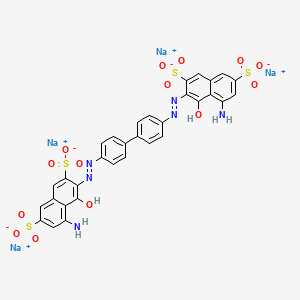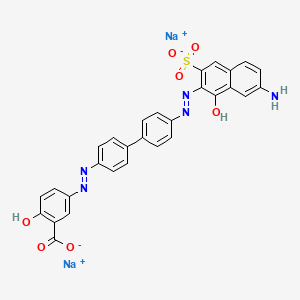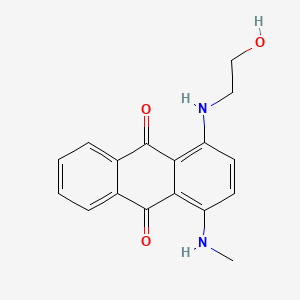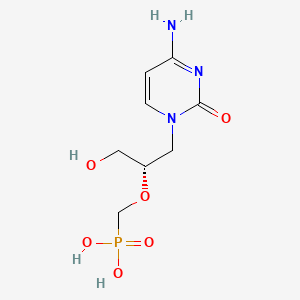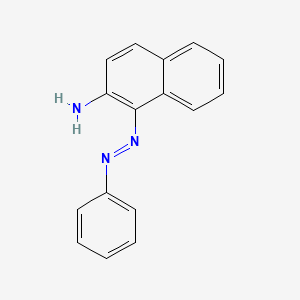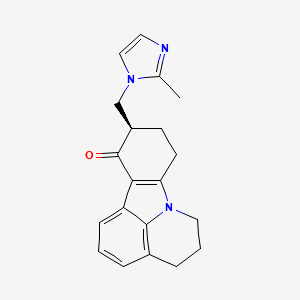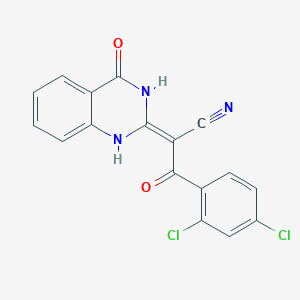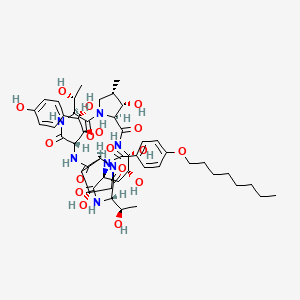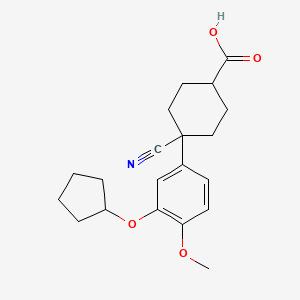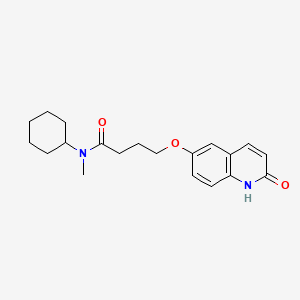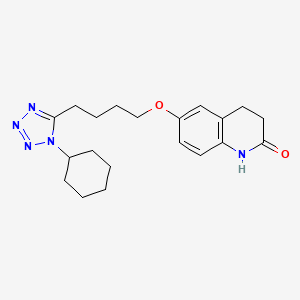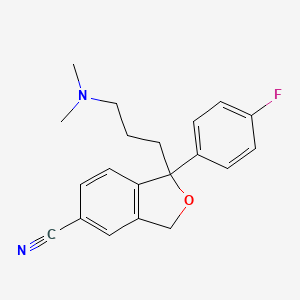
シタロプラム
概要
説明
シタロプラムは、選択的セロトニン再取り込み阻害薬(SSRI)であり、抗うつ薬として広く使用されています。 主に、主要なうつ病、強迫性障害、パニック障害、社会不安障害の治療に処方されます . シタロプラムは、脳内の神経伝達物質であるセロトニンの再取り込みを阻害することにより、セロトニン作動性伝達を増強します .
作用機序
シタロプラムは、シナプス前ニューロンにおけるセロトニンの再取り込みを選択的に阻害することにより、シナプス間隙のセロトニン濃度を増加させることにより作用します . この作用は、セロトニン作動性伝達を増強し、うつ病や不安の症状を軽減します . シタロプラムは、ドーパミンおよびノルエピネフリン輸送体への影響は最小限であり、他の受容体サブタイプへの親和性はほとんどありません .
類似の化合物との比較
シタロプラムは、以下のような他の選択的セロトニン再取り込み阻害薬(SSRI)と比較されます。
エシタロプラム: 主要なうつ病の急性反応と寛解を達成する上で、シタロプラムよりも有効です.
フルオキセチン: 有効性は似ていますが、副作用のプロフィールが異なります.
パロキセチン: シタロプラムはより有効であり、副作用のプロフィールが良好です.
シタロプラムの独自性は、セロトニンの再取り込み阻害に対する高い選択性と、他の神経伝達物質系との最小限の相互作用にあります .
科学的研究の応用
Citalopram has a wide range of scientific research applications:
Chemistry: Used as a model compound in studies of selective serotonin reuptake inhibitors.
Biology: Investigated for its effects on neurotransmitter systems and cellular pathways.
Medicine: Extensively studied for its efficacy in treating various psychiatric disorders.
Industry: Utilized in the development of optical nanosensors for rapid detection.
生化学分析
Biochemical Properties
Citalopram enhances serotonergic transmission through the inhibition of serotonin reuptake . Among all the SSRIs, citalopram is the most selective toward serotonin reuptake inhibition . Specifically, it has a very minimal effect on dopamine and norepinephrine transportation and virtually no affinity for muscarinic, histaminergic, or GABAergic receptors .
Cellular Effects
Citalopram has been shown to have various effects on cells. For instance, it can cause side effects such as drowsiness, somnolence, hyponatremia, dizziness, and tachycardia . It can also treat depression, and panic disorders in adults .
Molecular Mechanism
The mechanism of action of citalopram is presumed to be related to potentiation of serotonergic activity in the central nervous system (CNS) resulting from its inhibition of CNS neuronal reuptake of serotonin (5-HT), potentially through the inhibition of the serotonin transporter (solute carrier family 6 member 4, SLC6A4) .
Temporal Effects in Laboratory Settings
The therapeutic effects of all antidepressants, including citalopram, develop over several weeks . This could be possibly as a result of adaptive changes in receptors . Adverse effects associated with citalopram therapy include drowsiness, somnolence, hyponatremia, dizziness, and tachycardia .
Dosage Effects in Animal Models
In several animal models, citalopram reduces serotonin turnover, presumably secondary to the increased intrasynaptic serotonin levels resulting from reuptake inhibition . Citalopram produced a mixed anxiogenic-/anxiolytic-like response in rats tested in the two-compartment black and white box .
Metabolic Pathways
Citalopram is metabolized mainly in the liver via N-demethylation to its main metabolite, demethylcitalopram by CYP2C19 and CYP3A4 . Other metabolites include didemethylcitalopram via CYP2D6 metabolism, citalopram N-oxide and propionic acid derivative via monoamine oxidase enzymes A and B and aldehyde oxidase .
Transport and Distribution
Citalopram is extensively hepatic, via CYP3A4 and 2C19 (major pathways), and 2D6 (minor pathway); metabolized to demethylcitalopram (DCT), didemethylcitalopram (DDCT), citalopram-N-oxide, and a deaminated propionic acid derivative, which are at least eight times less potent than citalopram .
Subcellular Localization
Given its mechanism of action, it is likely that citalopram is localized in the synaptic cleft where it inhibits the reuptake of serotonin, thereby increasing the concentration of serotonin in this region .
準備方法
合成経路と反応条件
シタロプラムの合成には、いくつかの重要なステップが含まれます。
ベンゾフェノン誘導体の還元: プロセスは、プロトン性溶媒の存在下で、ナトリウムボロハイドライドを使用して、ベンゾフェノン誘導体の分離できないマグネシウム塩を還元することから始まります.
中間体の生成: 還元された化合物は、次に、非極性溶媒中で酸触媒と反応させて、中間体を取得します.
シアン化銅(I)との反応: 中間体は、極性溶媒媒体中でシアン化銅(I)と反応させ、次に極性および/またはアルコール性溶媒を使用して再結晶化して、シアノ化合物を取得します.
最終的な変換: 次に、シアノ化合物は、従来の方法でシタロプラムに変換されます.
工業生産方法
シタロプラムの工業生産は、同様の合成経路に従いますが、大規模製造向けに最適化されています。 プロセスには、最終生成物の高収率と純度を確保するために、反応条件を厳密に管理することが含まれます .
化学反応の分析
反応の種類
シタロプラムは、さまざまな化学反応を起こします。これには、以下が含まれます。
熱分解: シタロプラムは、189.3°Cで融解した後、単一ステップで分解し、臭化水素、ジメチルアミン、フルオロベンゼンを放出します.
酸化と還元: これらの反応はあまり一般的ではありませんが、特定の条件下で発生する可能性があります。
一般的な試薬と条件
ナトリウムボロハイドライド: 合成の還元段階で使用されます.
シアン化銅(I): シアノ化合物の生成に使用されます.
酸触媒: 中間体の生成段階で使用されます.
生成される主な生成物
臭化水素: 熱分解中に放出されます.
ジメチルアミンとフルオロベンゼン: 熱分解の副生成物.
科学研究の応用
シタロプラムは、幅広い科学研究の応用を持っています。
類似化合物との比較
Citalopram is compared with other selective serotonin reuptake inhibitors (SSRIs) such as:
Escitalopram: More efficacious than citalopram in achieving acute response and remission in major depressive disorder.
Fluoxetine: Similar efficacy but different side effect profiles.
Paroxetine: Citalopram is more efficacious and has a better side effect profile.
Citalopram’s uniqueness lies in its high selectivity for serotonin reuptake inhibition and minimal interaction with other neurotransmitter systems .
特性
IUPAC Name |
1-[3-(dimethylamino)propyl]-1-(4-fluorophenyl)-3H-2-benzofuran-5-carbonitrile | |
|---|---|---|
| Source | PubChem | |
| URL | https://pubchem.ncbi.nlm.nih.gov | |
| Description | Data deposited in or computed by PubChem | |
InChI |
InChI=1S/C20H21FN2O/c1-23(2)11-3-10-20(17-5-7-18(21)8-6-17)19-9-4-15(13-22)12-16(19)14-24-20/h4-9,12H,3,10-11,14H2,1-2H3 | |
| Source | PubChem | |
| URL | https://pubchem.ncbi.nlm.nih.gov | |
| Description | Data deposited in or computed by PubChem | |
InChI Key |
WSEQXVZVJXJVFP-UHFFFAOYSA-N | |
| Source | PubChem | |
| URL | https://pubchem.ncbi.nlm.nih.gov | |
| Description | Data deposited in or computed by PubChem | |
Canonical SMILES |
CN(C)CCCC1(C2=C(CO1)C=C(C=C2)C#N)C3=CC=C(C=C3)F | |
| Source | PubChem | |
| URL | https://pubchem.ncbi.nlm.nih.gov | |
| Description | Data deposited in or computed by PubChem | |
Molecular Formula |
C20H21FN2O | |
| Source | PubChem | |
| URL | https://pubchem.ncbi.nlm.nih.gov | |
| Description | Data deposited in or computed by PubChem | |
DSSTOX Substance ID |
DTXSID8022826 | |
| Record name | Citalopram | |
| Source | EPA DSSTox | |
| URL | https://comptox.epa.gov/dashboard/DTXSID8022826 | |
| Description | DSSTox provides a high quality public chemistry resource for supporting improved predictive toxicology. | |
Molecular Weight |
324.4 g/mol | |
| Source | PubChem | |
| URL | https://pubchem.ncbi.nlm.nih.gov | |
| Description | Data deposited in or computed by PubChem | |
Physical Description |
Solid | |
| Record name | Citalopram | |
| Source | Human Metabolome Database (HMDB) | |
| URL | http://www.hmdb.ca/metabolites/HMDB0005038 | |
| Description | The Human Metabolome Database (HMDB) is a freely available electronic database containing detailed information about small molecule metabolites found in the human body. | |
| Explanation | HMDB is offered to the public as a freely available resource. Use and re-distribution of the data, in whole or in part, for commercial purposes requires explicit permission of the authors and explicit acknowledgment of the source material (HMDB) and the original publication (see the HMDB citing page). We ask that users who download significant portions of the database cite the HMDB paper in any resulting publications. | |
Boiling Point |
347-358, BP: 175-181 °C at 0.03 mm Hg /Citalopram/ | |
| Record name | Citalopram | |
| Source | DrugBank | |
| URL | https://www.drugbank.ca/drugs/DB00215 | |
| Description | The DrugBank database is a unique bioinformatics and cheminformatics resource that combines detailed drug (i.e. chemical, pharmacological and pharmaceutical) data with comprehensive drug target (i.e. sequence, structure, and pathway) information. | |
| Explanation | Creative Common's Attribution-NonCommercial 4.0 International License (http://creativecommons.org/licenses/by-nc/4.0/legalcode) | |
| Record name | Citalopram | |
| Source | Hazardous Substances Data Bank (HSDB) | |
| URL | https://pubchem.ncbi.nlm.nih.gov/source/hsdb/7042 | |
| Description | The Hazardous Substances Data Bank (HSDB) is a toxicology database that focuses on the toxicology of potentially hazardous chemicals. It provides information on human exposure, industrial hygiene, emergency handling procedures, environmental fate, regulatory requirements, nanomaterials, and related areas. The information in HSDB has been assessed by a Scientific Review Panel. | |
Solubility |
Sparingly soluble, log Kow = 1.39 at 22 °C.Solubility in water = 15,460 mg/L at 22 °C /Citalopram hydrobromide/, ... Sparingly soluble in water and soluble in ethanol. | |
| Record name | Citalopram | |
| Source | DrugBank | |
| URL | https://www.drugbank.ca/drugs/DB00215 | |
| Description | The DrugBank database is a unique bioinformatics and cheminformatics resource that combines detailed drug (i.e. chemical, pharmacological and pharmaceutical) data with comprehensive drug target (i.e. sequence, structure, and pathway) information. | |
| Explanation | Creative Common's Attribution-NonCommercial 4.0 International License (http://creativecommons.org/licenses/by-nc/4.0/legalcode) | |
| Record name | Citalopram | |
| Source | Hazardous Substances Data Bank (HSDB) | |
| URL | https://pubchem.ncbi.nlm.nih.gov/source/hsdb/7042 | |
| Description | The Hazardous Substances Data Bank (HSDB) is a toxicology database that focuses on the toxicology of potentially hazardous chemicals. It provides information on human exposure, industrial hygiene, emergency handling procedures, environmental fate, regulatory requirements, nanomaterials, and related areas. The information in HSDB has been assessed by a Scientific Review Panel. | |
Mechanism of Action |
The mechanism of action of citalopram results from its inhibition of CNS neuronal reuptake of serotonin (5-HT). The molecular target for citalopram is the serotonin transporter (solute carrier family 6 member 4, _SLC6A4_), inhibiting its serotonin reuptake in the synaptic cleft. Citalopram binds with significantly less affinity to histamine, acetylcholine, and norepinephrine receptors than tricyclic antidepressant drugs. This drug has no or neglible affinity for _5-HT1A_, _5-HT2A_, _dopamine D_1 and _D2_, _α1-_, _α2_-, and_ β adrenergic_, _histamine H1_, _gamma-aminobutyric acid_ (GABA), _muscarinic_, _cholinergic_, and _benzodiazepine_ receptors. Antagonism of _muscarinic_, _histaminergic_, and _adrenergic receptors_ is thought to be associated with several anticholinergic, sedative, and cardiovascular effects of other psychotropic drugs., /In/ whole-cell patch clamp recording of heterologous HERG-mediated currents in transfected mammalian cells ... citalopram blocks HERG with an IC(50) of 3.97 uM. This is slightly less potent than fluoxetine in /the same/ system (IC(50) of 1.50 uM). In isolated guinea pig ventricular cardiomyocytes, citalopram inhibited L-type calcium current (I(Ca,L)). The voltage dependence of I(Ca,L) inactivation in the presence of 100 uM citalopram was shifted significantly leftward. As a result, the I(Ca,L) 'window' in citalopram was found to be smaller & leftward-shifted compared to control. /These/ effects ... may help to explain citalopram's good cardiac safety profile, given its propensity to block HERG at excessive dosages. /Salt not specified/, The study was aimed to investigate the effects of the minimal effective doses of acute citalopram (5 mg/kg), (+/-)-8-hydroxydipropylaminotetralin HBr (8-OH-DPAT; 0.1 mg/kg), & their combined treatment on the rat open field & forced swimming behaviour & post-mortem monoamine content. The animals were prospectively divided into the vehicle- and para-chlorophenylalanine (p-CPA)-pretreated (350 mg/kg) groups. Acute citalopram (5 mg/kg), 8-OH-DPAT (0.1 mg/kg), or their combined treatment had no major effect on the rat open field & forced swimming behaviour. The post-mortem catecholamine content in four brain regions studied was unchanged in all treatment groups. The combined 8-OH-DPAT (0.1 mg/kg) & citalopram (5 mg/kg) treatment partially reversed the p-CPA-induced decr of serotonin (5-HT) and 5-hydroxy-indolacetic acid (5-HIAA) content. The present experiments demonstrate that the 5-HT1A receptors mediate some of the selective serotonin reuptake inhibitor-induced biochemical phenomena. | |
| Record name | Citalopram | |
| Source | DrugBank | |
| URL | https://www.drugbank.ca/drugs/DB00215 | |
| Description | The DrugBank database is a unique bioinformatics and cheminformatics resource that combines detailed drug (i.e. chemical, pharmacological and pharmaceutical) data with comprehensive drug target (i.e. sequence, structure, and pathway) information. | |
| Explanation | Creative Common's Attribution-NonCommercial 4.0 International License (http://creativecommons.org/licenses/by-nc/4.0/legalcode) | |
| Record name | Citalopram | |
| Source | Hazardous Substances Data Bank (HSDB) | |
| URL | https://pubchem.ncbi.nlm.nih.gov/source/hsdb/7042 | |
| Description | The Hazardous Substances Data Bank (HSDB) is a toxicology database that focuses on the toxicology of potentially hazardous chemicals. It provides information on human exposure, industrial hygiene, emergency handling procedures, environmental fate, regulatory requirements, nanomaterials, and related areas. The information in HSDB has been assessed by a Scientific Review Panel. | |
Color/Form |
Fine white to off-white powder | |
CAS No. |
59729-33-8 | |
| Record name | Citalopram | |
| Source | CAS Common Chemistry | |
| URL | https://commonchemistry.cas.org/detail?cas_rn=59729-33-8 | |
| Description | CAS Common Chemistry is an open community resource for accessing chemical information. Nearly 500,000 chemical substances from CAS REGISTRY cover areas of community interest, including common and frequently regulated chemicals, and those relevant to high school and undergraduate chemistry classes. This chemical information, curated by our expert scientists, is provided in alignment with our mission as a division of the American Chemical Society. | |
| Explanation | The data from CAS Common Chemistry is provided under a CC-BY-NC 4.0 license, unless otherwise stated. | |
| Record name | Citalopram [USP:INN:BAN] | |
| Source | ChemIDplus | |
| URL | https://pubchem.ncbi.nlm.nih.gov/substance/?source=chemidplus&sourceid=0059729338 | |
| Description | ChemIDplus is a free, web search system that provides access to the structure and nomenclature authority files used for the identification of chemical substances cited in National Library of Medicine (NLM) databases, including the TOXNET system. | |
| Record name | Citalopram | |
| Source | DrugBank | |
| URL | https://www.drugbank.ca/drugs/DB00215 | |
| Description | The DrugBank database is a unique bioinformatics and cheminformatics resource that combines detailed drug (i.e. chemical, pharmacological and pharmaceutical) data with comprehensive drug target (i.e. sequence, structure, and pathway) information. | |
| Explanation | Creative Common's Attribution-NonCommercial 4.0 International License (http://creativecommons.org/licenses/by-nc/4.0/legalcode) | |
| Record name | Citalopram | |
| Source | EPA DSSTox | |
| URL | https://comptox.epa.gov/dashboard/DTXSID8022826 | |
| Description | DSSTox provides a high quality public chemistry resource for supporting improved predictive toxicology. | |
| Record name | Citalopram | |
| Source | European Chemicals Agency (ECHA) | |
| URL | https://echa.europa.eu/substance-information/-/substanceinfo/100.056.247 | |
| Description | The European Chemicals Agency (ECHA) is an agency of the European Union which is the driving force among regulatory authorities in implementing the EU's groundbreaking chemicals legislation for the benefit of human health and the environment as well as for innovation and competitiveness. | |
| Explanation | Use of the information, documents and data from the ECHA website is subject to the terms and conditions of this Legal Notice, and subject to other binding limitations provided for under applicable law, the information, documents and data made available on the ECHA website may be reproduced, distributed and/or used, totally or in part, for non-commercial purposes provided that ECHA is acknowledged as the source: "Source: European Chemicals Agency, http://echa.europa.eu/". Such acknowledgement must be included in each copy of the material. ECHA permits and encourages organisations and individuals to create links to the ECHA website under the following cumulative conditions: Links can only be made to webpages that provide a link to the Legal Notice page. | |
| Record name | CITALOPRAM | |
| Source | FDA Global Substance Registration System (GSRS) | |
| URL | https://gsrs.ncats.nih.gov/ginas/app/beta/substances/0DHU5B8D6V | |
| Description | The FDA Global Substance Registration System (GSRS) enables the efficient and accurate exchange of information on what substances are in regulated products. Instead of relying on names, which vary across regulatory domains, countries, and regions, the GSRS knowledge base makes it possible for substances to be defined by standardized, scientific descriptions. | |
| Explanation | Unless otherwise noted, the contents of the FDA website (www.fda.gov), both text and graphics, are not copyrighted. They are in the public domain and may be republished, reprinted and otherwise used freely by anyone without the need to obtain permission from FDA. Credit to the U.S. Food and Drug Administration as the source is appreciated but not required. | |
| Record name | Citalopram | |
| Source | Hazardous Substances Data Bank (HSDB) | |
| URL | https://pubchem.ncbi.nlm.nih.gov/source/hsdb/7042 | |
| Description | The Hazardous Substances Data Bank (HSDB) is a toxicology database that focuses on the toxicology of potentially hazardous chemicals. It provides information on human exposure, industrial hygiene, emergency handling procedures, environmental fate, regulatory requirements, nanomaterials, and related areas. The information in HSDB has been assessed by a Scientific Review Panel. | |
| Record name | Citalopram | |
| Source | Human Metabolome Database (HMDB) | |
| URL | http://www.hmdb.ca/metabolites/HMDB0005038 | |
| Description | The Human Metabolome Database (HMDB) is a freely available electronic database containing detailed information about small molecule metabolites found in the human body. | |
| Explanation | HMDB is offered to the public as a freely available resource. Use and re-distribution of the data, in whole or in part, for commercial purposes requires explicit permission of the authors and explicit acknowledgment of the source material (HMDB) and the original publication (see the HMDB citing page). We ask that users who download significant portions of the database cite the HMDB paper in any resulting publications. | |
Melting Point |
182-188, Crystals from isopropanol. MP: 182-183. Freely soluble in water, ethanol, chloroform /Citolapram hydrobromide/, 178 °C | |
| Record name | Citalopram | |
| Source | DrugBank | |
| URL | https://www.drugbank.ca/drugs/DB00215 | |
| Description | The DrugBank database is a unique bioinformatics and cheminformatics resource that combines detailed drug (i.e. chemical, pharmacological and pharmaceutical) data with comprehensive drug target (i.e. sequence, structure, and pathway) information. | |
| Explanation | Creative Common's Attribution-NonCommercial 4.0 International License (http://creativecommons.org/licenses/by-nc/4.0/legalcode) | |
| Record name | Citalopram | |
| Source | Hazardous Substances Data Bank (HSDB) | |
| URL | https://pubchem.ncbi.nlm.nih.gov/source/hsdb/7042 | |
| Description | The Hazardous Substances Data Bank (HSDB) is a toxicology database that focuses on the toxicology of potentially hazardous chemicals. It provides information on human exposure, industrial hygiene, emergency handling procedures, environmental fate, regulatory requirements, nanomaterials, and related areas. The information in HSDB has been assessed by a Scientific Review Panel. | |
| Record name | Citalopram | |
| Source | Human Metabolome Database (HMDB) | |
| URL | http://www.hmdb.ca/metabolites/HMDB0005038 | |
| Description | The Human Metabolome Database (HMDB) is a freely available electronic database containing detailed information about small molecule metabolites found in the human body. | |
| Explanation | HMDB is offered to the public as a freely available resource. Use and re-distribution of the data, in whole or in part, for commercial purposes requires explicit permission of the authors and explicit acknowledgment of the source material (HMDB) and the original publication (see the HMDB citing page). We ask that users who download significant portions of the database cite the HMDB paper in any resulting publications. | |
Synthesis routes and methods I
Procedure details





Synthesis routes and methods II
Procedure details








Synthesis routes and methods III
Procedure details







Synthesis routes and methods IV
Procedure details










Synthesis routes and methods V
Procedure details








Retrosynthesis Analysis
AI-Powered Synthesis Planning: Our tool employs the Template_relevance Pistachio, Template_relevance Bkms_metabolic, Template_relevance Pistachio_ringbreaker, Template_relevance Reaxys, Template_relevance Reaxys_biocatalysis model, leveraging a vast database of chemical reactions to predict feasible synthetic routes.
One-Step Synthesis Focus: Specifically designed for one-step synthesis, it provides concise and direct routes for your target compounds, streamlining the synthesis process.
Accurate Predictions: Utilizing the extensive PISTACHIO, BKMS_METABOLIC, PISTACHIO_RINGBREAKER, REAXYS, REAXYS_BIOCATALYSIS database, our tool offers high-accuracy predictions, reflecting the latest in chemical research and data.
Strategy Settings
| Precursor scoring | Relevance Heuristic |
|---|---|
| Min. plausibility | 0.01 |
| Model | Template_relevance |
| Template Set | Pistachio/Bkms_metabolic/Pistachio_ringbreaker/Reaxys/Reaxys_biocatalysis |
| Top-N result to add to graph | 6 |
Feasible Synthetic Routes
Q1: What is the primary mechanism of action of Citalopram?
A1: Citalopram primarily acts by inhibiting the serotonin transporter (SERT), a protein responsible for the reuptake of serotonin from the synaptic cleft back into the presynaptic neuron. This inhibition effectively increases the concentration of serotonin in the synapse, enhancing serotonergic neurotransmission. [, , ]
Q2: Does Citalopram interact with other molecular targets besides SERT?
A2: While Citalopram exhibits high selectivity for SERT, research indicates it can also interact with other molecular targets, including certain potassium channels. Notably, it inhibits TREK-1, TREK-2, and TRESK potassium channels, which are involved in regulating neuronal excitability. []
Q3: How does Citalopram's S-enantiomer, Escitalopram, differ in its interaction with SERT?
A3: Escitalopram demonstrates a higher affinity for SERT compared to the racemic Citalopram mixture. This difference in binding affinity contributes to its potentially faster onset of action and greater efficacy. [, , ]
Q4: What is the role of the R-enantiomer of Citalopram?
A4: The R-enantiomer of Citalopram, while not directly contributing to the therapeutic effect, has been shown to potentially inhibit the binding of the S-enantiomer to SERT, thereby potentially reducing its efficacy. []
Q5: How does chronic Citalopram treatment affect the adrenal gland's response to adrenocorticotropic hormone (ACTH)?
A5: Research suggests that chronic Citalopram treatment does not appear to sensitize the adrenal gland to ACTH in rats. While Citalopram-treated rats can elicit a corticosterone response to stress, this response is not accompanied by increased ACTH levels, suggesting alternative mechanisms may be involved. []
Q6: Has Citalopram been investigated for potential anti-cancer effects?
A6: Research indicates that Citalopram exhibits anti-proliferative activity against certain cancer cell lines, including the liver hepatocellular carcinoma cell line HepG2. This effect has been linked to the induction of apoptosis through mechanisms involving cytochrome C release and reactive oxygen species (ROS)-dependent activation of nuclear factor-κB (NF-κB). []
Q7: How do structural modifications of the Citalopram molecule influence its activity and selectivity?
A7: While the provided research papers do not extensively cover specific structural modifications and their impact, it is generally understood that even subtle alterations to the Citalopram molecule can significantly affect its binding affinity for SERT and other targets, potentially altering its pharmacological profile. This emphasizes the importance of SAR studies in drug development to optimize efficacy and minimize off-target effects. [General knowledge based on the field of medicinal chemistry]
Q8: How is Citalopram metabolized in the body?
A9: Citalopram is primarily metabolized in the liver by cytochrome P450 (CYP) enzymes, mainly CYP2C19, with CYP3A4 and CYP2D6 playing minor roles. The primary metabolite, desmethylcitalopram, also exhibits pharmacological activity. [, , , ]
Q9: How does CYP2C19 genotype influence Citalopram metabolism and potential for adverse effects?
A10: Individuals classified as "slow metabolizers" due to genetic variations in the CYP2C19 gene may experience higher plasma concentrations of Citalopram compared to "normal metabolizers" receiving the same dose. This can lead to an increased risk of side effects and requires careful dose adjustments. [, , , ]
Q10: What in vitro models have been used to study the effects of Citalopram on neural cells?
A12: Rat PC12 cells have been utilized as an in vitro model to investigate the neuroprotective potential of Citalopram. Studies demonstrated that Citalopram exhibited anti-apoptotic effects on serum-deprived PC12 cells, potentially mediated by the upregulation of brain-derived neurotrophic factor (BDNF). []
Q11: What animal models have been used to investigate the effects of Citalopram on depression-related behaviors?
A13: The rat chronic mild stress (CMS) model, a well-established animal model of depression, has been employed to evaluate the antidepressant-like effects of Citalopram. Results showed that Citalopram effectively reversed CMS-induced behavioral deficits, further supporting its therapeutic potential. []
Q12: How does the time to response for Citalopram compare to other antidepressants in the rat CMS model?
A14: In the rat CMS model, Citalopram exhibited a faster onset of action compared to the tricyclic antidepressant imipramine and the SSRI fluoxetine, indicating potential advantages in terms of treatment response time. []
Q13: What cardiac effects have been associated with Citalopram, and what precautions are recommended?
A15: Citalopram, particularly at higher doses or in individuals with certain risk factors, has been associated with QTc interval prolongation on electrocardiograms (ECGs), a risk factor for potentially fatal ventricular arrhythmias like torsade de pointes. Regulatory bodies recommend dose adjustments and careful monitoring in patients with a history of cardiac conditions, electrolyte disturbances, or those taking medications known to prolong the QTc interval. [, , , ]
Q14: Is there a reliable ECG marker to predict the risk of ventricular arrhythmias in Citalopram intoxication?
A16: Research suggests that the QRS/QTc ratio, a novel ECG marker, shows promise in predicting ventricular arrhythmia risk in Citalopram intoxication. Patients experiencing ventricular arrhythmias exhibited significantly lower QRS/QTc ratios compared to those without arrhythmias. []
Q15: How does Escitalopram compare to other antidepressants in terms of efficacy and tolerability?
A17: Meta-analyses of clinical trials suggest that Escitalopram demonstrates comparable or superior efficacy to other SSRIs, such as Citalopram, Fluoxetine, Paroxetine, and Sertraline, in treating major depressive disorder. It may also have a more favorable tolerability profile compared to some other antidepressants. [, , , , ]
Q16: Are there non-pharmacological alternatives or adjunctive therapies for depression that can be considered?
A16: Yes, various non-pharmacological interventions, such as cognitive behavioral therapy (CBT), interpersonal therapy, and other forms of psychotherapy, have proven effective in treating depression. These therapies can be used alone or in conjunction with medication, depending on the individual patient's needs and preferences. [General knowledge based on the field of psychiatry]
Q17: What analytical methods are commonly employed for the quantification of Citalopram and its metabolites in biological samples?
A19: High-performance liquid chromatography (HPLC) coupled with various detection methods, such as ultraviolet (UV) detection or mass spectrometry (MS), is widely used for the accurate and sensitive quantification of Citalopram and its metabolites in plasma and other biological matrices. [, , ]
Q18: What sample preparation techniques are often used prior to HPLC analysis of Citalopram in biological samples?
A20: Solid-phase extraction (SPE) is a common sample preparation technique used to extract and purify Citalopram from biological matrices, such as plasma, prior to HPLC analysis. This technique helps to remove interfering compounds and concentrate the analyte of interest, improving the sensitivity and reliability of the analysis. [, ]
Q19: Have thin-layer chromatography (TLC) methods been explored for the analysis of Citalopram?
A21: Yes, TLC coupled with densitometric analysis has been investigated as a potential method for the simultaneous analysis of Citalopram and other centrally acting serotonin reuptake inhibitors. []
試験管内研究製品の免責事項と情報
BenchChemで提示されるすべての記事および製品情報は、情報提供を目的としています。BenchChemで購入可能な製品は、生体外研究のために特別に設計されています。生体外研究は、ラテン語の "in glass" に由来し、生物体の外で行われる実験を指します。これらの製品は医薬品または薬として分類されておらず、FDAから任何の医療状態、病気、または疾患の予防、治療、または治癒のために承認されていません。これらの製品を人間または動物に体内に導入する形態は、法律により厳格に禁止されています。これらのガイドラインに従うことは、研究と実験において法的および倫理的な基準の遵守を確実にするために重要です。

